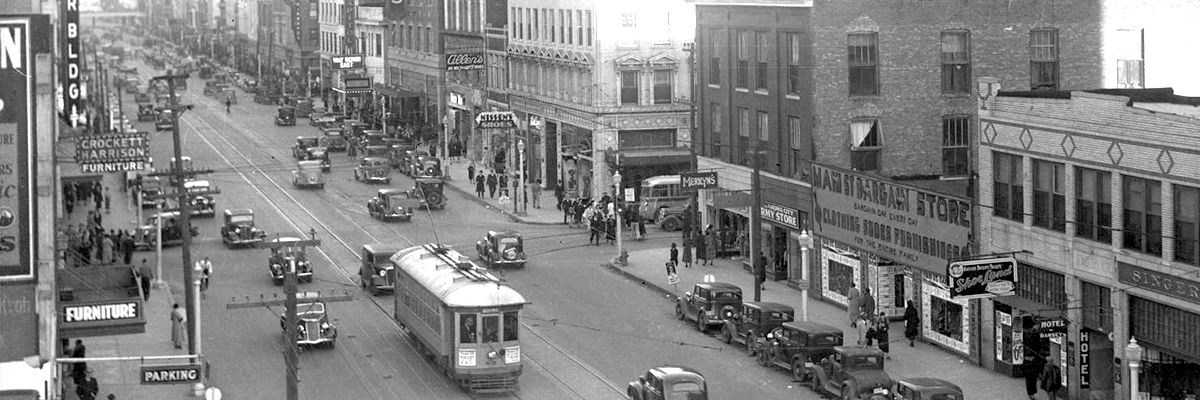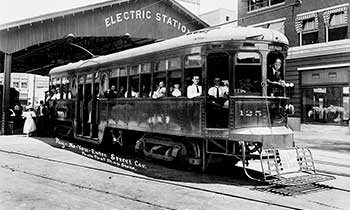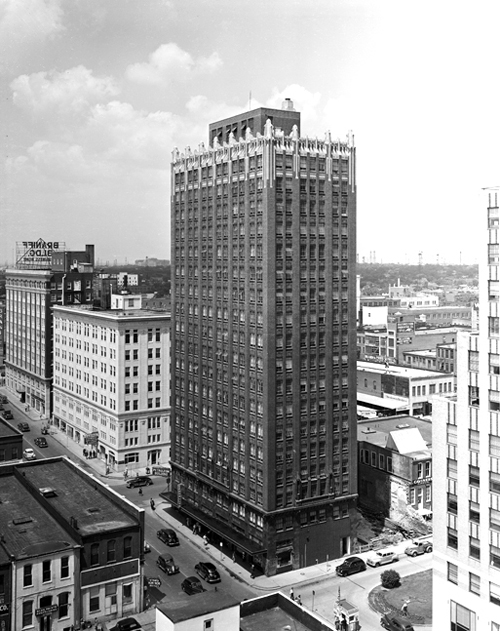
Photograph Archives
Orders and Fees
Permissions
Commercial Use
Contact
Donations
Preservation
FAQs
The Oklahoma Historical Society first collected photographic images in 1893; today there are an estimated 11 million images in the Photograph Archives. Formats include glass plates, tintypes, slides, panoramas, black-and-white and color prints, and negatives. The collection provides examples of Oklahoma's cultural, social, political, military, and business history, along with many other aspects. Some of the larger collections held by the Photograph Archives include the Z. P. Meyers/Barney Hillerman Photographic Collection, the Ray Jacoby Collection, and the Jim Argo Collection.
The Gateway to
Oklahoma History
Search the
Archives Catalog
Order Photos
Online
“How to Search The Gateway” Video Tutorial
Orders and Fees
To order specific photos visit the online store. To expedite your request, you must enter the information accurately in all fields. If you do not know the collection name, enter "unknown" in the box.
When ordering through the online store, you will not pay for your order until we send you a final invoice. After you remit payment, we will email a link to your images and permission letter (if needed). Please note: you must download the files to your computer before opening.
Once an order or photograph request is made, fees will be invoiced and due for the work and product produced. Orders may not be canceled once the process has begun. It may take up to three weeks to complete an order. A rush order may be requested for double the fees, including research and use fees. A rush order may be completed in three days or a week. You will be invoiced and payment must be received before your order is filled.
Research fees are nonnegotiable and nonrefundable. If you do not have specific OHS photograph accession numbers, the fee for photograph research is $35 per hour for out-of-state residents or organizations and $25 per hour for Oklahoma residents or organizations. Please be sure to state sizes when requesting prints; for digital orders, indicate JPG or TIFF.
Order Online
You may also order by mail using our printable forms: order prints | order scans
| Resolution | Price | |
|---|---|---|
| 300 dpi | $16 per scan | |
| 600 dpi | $18 per scan | |
| 1200 dpi | $35 per scan | |
| Images on DVD | $8 per DVD | |
| Emailed Images | $1 per image | |
| Shipping | $5 minimum | |
| Size | Price |
|---|---|
| 5″x7″ | $16 |
| 8″x10″ | $18 |
| 11″x14″ | $25 |
| 16″x20″ | $40 |
| Shipping | $5 minimum |
Permissions
Permission is not required for non-profit educational purposes, although the OHS must be cited as the source. Permission language includes "all media, all languages, worldwide rights in perpetuity." The OHS does not sign external permission forms/materials releases, nor are our terms negotiable.
Image Use Fees
| Commercial | Non-Profit |
|---|---|
| $85 per image | $35 per image |
Image Standards
Photographs are custom-printed to fill specific orders, and cannot be sent on approval or returned for credit. We do not retouch prints or eliminate existing imperfections including lines resulting from cracks in glass plates. Any adjustment made to the original image, such as cropping, superimposition, tinting, retouching, digital enhancement, etc. must be indicated in the accompanying caption or label.
Videotaping
Filming is permitted at the discretion of the photo archivist. Research must be completed, images approved, and an appointment scheduled in advance of the filming session. School use is an exception.
Publishers Obligations
Publishers shall furnish the Oklahoma Historical Society Research Division, without charge, one copy of each publication or book in which the Society is indicated as being their source. Use fee payments are due prior to the time of publication and should be clearly marked "use fee for photos." The OHS does not give exclusive rights to any publisher, author, or photographer, and assumes no responsibility for duplication of subjects by others and no responsibilities for claims by third parties.
Credit Lines
A proper credit line is mandatory. Unless otherwise specified, all reproductions must be credited as follows: name of photographer (if known), collection (if given), "Courtesy of the Oklahoma Historical Society," and followed by the identifying number. With printed matter, it is preferred that the credit appears on the same, or page facing, the illustration, or, with other "sources of illustrations." Each reproduction must be individually credited. With films, filmstrips, and video usage the credit should be included with other "sources of illustrations." In the case of exhibitions, credits must appear in the exhibition area.
Exceptions to Fees
The OHS reserves the right to waive use fees for the use of photographs by the Oklahoma news media in newspaper articles, newscasts, or noncommercial documentaries. In-state nonprofit organizations may also qualify for the waiver. Waiver requests must be in writing. Please include your federal or state tax identification number. Proof of credit must be supplied before a fee can be considered for waiver.
The copyright law of the United States (Title 17, U.S. Code) governs the making of photocopies or other reproductions of copyrighted material. Under certain conditions specified in the law, libraries and archives are authorized to furnish a photocopy or other reproduction. One of the specified conditions is that the photocopy for reproduction is not used for any purpose other than private study, scholarship, or research. If a user makes a request for, or later uses, a photocopy or reproduction for purposes in excess of "fair use," that user may be liable for copyright infringement. This institution reserves the right to refuse to accept a copying order if, in its judgment, fulfillment of this order would involve violation of the copyright law. The Oklahoma Historical Society assumes no responsibility for resolving questions concerning copyright.
Contact the Photograph Archives
Jon May
405-522-6116
Jon.May@history.ok.gov
Collection Highlights
Streetcars and Interurbans

Browse photographs
Downtown OKC

Hillerman Map Project
Donations
Many of our photo collections come from generous donors who want to preserve and impart their legacy. If the subject matter of the donation is consistent with our collection policy we are pleased to accept it. Collections are accepted at the discretion of the photo archivist. Donations of original prints and negatives protect against copyright problems and storage issues. Income from reproduction sales supports preservation efforts.
We do not accept photocopies or printouts on low-quality paper. Due to limited staff and equipment, we are unable to scan personal collections of photos or scrapbooks, nor can we promise a turnaround time for adding your donation to our catalog.
At the discretion of the photo archivist, we may accept born-digital images or scans from originals in digital formats. For information on born-digital photographs please visit OCLC’s essay Defining "born-digital"
Standards for digital images scanned from originals are different from those that are born-digital. See the table below for scanned image settings.
| dpi | Size | Color | Other |
|---|---|---|---|
When scanning images, adjust dpi based on the size of the image. The longest side of the image should equal 3,000 pixels.
| Size should be set to 100 percent of the original size | Positives and color negatives: 24-bit color Black and white negatives: 16-8 bit grayscale | If the reverse side of a positive print contains information of value, it should be scanned at 200dpi, grayscale. If the reverse contains another image, design, etc. of intrinsic value, it should be scanned with the standard settings. Scanner glass should be cleaned with a lint-free cloth between batches. |
Preservation
We preserve photos and negatives by providing an appropriate storage environment and by caring for them using professional guidelines and standards. Preservation is important to maintaining and protecting our state's photographic legacy. As with any item, photographs are subject to deterioration and wear. Some things that can affect the quality of a photographic print or negative:
- Temperature and humidity
- The acidity of the enclosures
- Insects and other pests
- Improper handling (bending, fingerprints, impressions, tearing)
- The inherent chemical composition of the item
- Storage environment (fumes, wood, etc.)
- Mold
Photo Care and Preservation
What can we do to ensure that print photographs and negatives retain their quality for years to come?
- Wear Cotton Gloves
Every time a person handles a print or negative with bare hands, a trace is left behind that alters the quality of the image. Even after we wash our hands there are still natural oils and residue. We don't always notice the damage created by direct handling right away, but the effects can develop over the years. - Storage Environment
One reason the storage environment for a collection is important is that temperature and humidity are two interdependent factors that can affect the quality of photographs. Temperature and relative humidity levels greater than 75° F and 60 percent will accelerate the deterioration of photos and negatives, and promote mold growth. - Enclosures
Black and white prints: buffered envelopes
Dye transfer prints: unbuffered papers or sleeves
Cellulose acetate negatives: alkaline buffered paper envelopes or sleeves
When writing on an envelope, use a pencil and be sure that there is no photograph or negative inside. The pressure from the pencil may leave a permanent impression on the image.
FAQ
- Can I come look through the photos in the archives?
Browsing the collections is not allowed for preservation and security reasons.
- If I am coming to place a photo order in person, do I need to make an appointment first?
Yes, and there are a few things you should know before planning your visit. It is important to schedule ahead of time so staff can prepare for your visit by conducting preliminary research. The archives hold approximately 9 million images in several different formats, of which only about half are processed. Locating a specific item can often involve a time-consuming multi-step process involving transfer documentation, printouts, preliminary finding aids, and indexes in various formats. This cannot effectively be done on an ad hoc basis while researchers wait in the Reading Room.
- Can you tell me how much my photo is worth?
The OHS does not do appraisals, nor do we recommend appraisers.
- What can you tell me about repairing and preserving my own photographs and negatives?
The American Institute for Conservation of Historic and Artistic Works provides a PDF handout about caring for your photographs and negatives.
- How can I determine when a photo was taken?
There are some clues to determining the date of a photo. These include the photo process used to create the image, the dress worn by individuals in the image and examination of items in the photograph such as automobiles, studio props, etc.
For further information see:
The Costume Detective: How to Date Old Photographs by the Costume
Dating Card Mounted Photographs
- What goes on in the archives?
Staff process photo orders, process, and accession new collections, and manage the general organization and operation of the office. We also conduct photo-related research for patrons. Upon request, staff members present programs detailing how the OHS collects, preserves, and shares photography collections.
Useful Links
- The Society of American Archivists offers Notes on Copyright, Restrictions, and Unprocessed Collections
- The Library of Congress
- Prints and Photographs Reading Room
- Prints and Photographs online catalog
- Popular Photographic Print Processes
- Frequently Asked Questions for photographs - includes information on preserving family photographs, care, and supplies
- Rochester Institution of Technology Image Permanence Institute
- Oklahoma Digital Prairie this resource from the Oklahoma Department of Libraries includes digital collections
- The American Institute for Conservation of Historic and Artistic Works provides a PDF handout on how to care for your photographs and negatives
- National Parks Service Museum Management Program Conserve O Grams include details about caring for objects, lists of suppliers, and bibliographies
- International Organization for Standardization – Photographic Processed Films, Plates and Papers – Filing Enclosures and Storage Containers, ISO Standard 18092:2001
Print Resources
- Care and Identification of 19th-Century Photographic Prints by James M. Reilly. Published by Eastman Kodak Company, 2001. Rochester, NY.
- Photographs: Archival Care and Management by Mary Lynn Ritzenthaler and Diane Vogt-O’Connor. Published by the Society of American Archivists, 2006. Chicago.
- Preserving Your Family Photographs: How to Organize, Present, and Restore Your Precious Family Images by Maureen A. Taylor. Published by Betterway Books, 2001.Cincinnati, OH.

